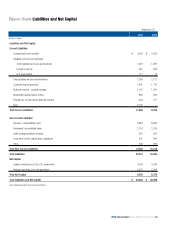US Postal Service 2006 Annual Report Download - page 37
Download and view the complete annual report
Please find page 37 of the 2006 US Postal Service annual report below. You can navigate through the pages in the report by either clicking on the pages listed below, or by using the keyword search tool below to find specific information within the annual report.2006 Annual Report United States Postal Service | 35
APPROPRIATIONS
Although the Postal Service is self-funded and does not receive an
appropriation for its operations, we have received appropriations to
reimburse us for un-funded statutorily-mandated services.
The 2006 House-passed bill and the Senate-reported bill both provide
Fiscal Year 2007 funding at almost $109 million, which includes $29
million for revenue forgone and almost $80 million for free matter for
the blind and overseas voters. These funds would not be available until
October 1, 2007. These amounts are subject to change because the
appropriations process was not finalized by our reporting deadline, and the
allocations could be subject to further congressional action.
ENERGY
A new Energy Initiatives Office was created in 2006 to bring a central
focus to our energy issues and to develop an integrated and strategic
energy plan that will reduce energy use, minimize the price paid for
energy, ensure that legal requirements are met and support continuity of
operations.
In 2006, the Postal Service paid nearly $2.4 billion in energy costs to
process, transport and deliver the mail. Postal energy costs increased
27% over 2005. The overall increase was driven by fuel which accounted
for 74% of our total energy costs.
With more than 216,000 vehicles, the Postal Service has the largest
civilian fleet in the United States. We continue to evaluate various fuel
types and alternative fuel vehicles including hybrid trucks, hydrogen fuel
cell vans, electric step vans and liquid natural gas delivery vehicles.
The Postal Service occupies more than 34,000 buildings and spent $671
million on utilities in 2006. This was a 16% increase over the previous
year. We also won the Presidential Award for Leadership in Federal Energy
Management as well as a Federal Energy and Water Management Award.
IDENTITY THEFT
Despite widespread expectations, none of the 2005 federal bills that
applied data breach notification requirements to private sector firms were
able to gain passage in Congress. In May 2006, President Bush directed
the Postmaster General and sixteen other agency heads to form the first
national Identity Theft Task Force.
The Postmaster General directed the Inspection Service to represent the
Postal Service on the Identity Theft Task Force. The Inspection Service
and Postal Service Privacy Office provided input that was incorporated
into the Task Force interim recommendations released in September.
The following day, the White House Office of Management of the Budget
issued the Task Force recommendations to all agencies, including the
requirement that government agencies use the mail to notify citizens of
data security breaches.
Transformation Plan
Since its publication in April 2002, our Transformation Plan has provided
focus and direction to all Postal Service business and operating activi-
ties. It is our principal planning tool for improving the value of mail and
sustaining a financially stable enterprise that meets the nation’s needs
for affordable and reliable universal service. The plan defines our vision
and establishes our strategic goals in the areas of service, revenue, cost
savings and human capital.
Transformation assures continuity between our longer-term direction and
our near-term corporate objectives, which are published each year as our
Annual Performance Plan. It bridges our internal priorities and operating
activities with events and conditions in our larger business environment.
Transformation in the Postal Service is designed to be dynamic and adapt-
able. For that reason, the plan was updated at the start of this fiscal year,
with the publication of the new Strategic Transformation Plan, 2006–2010,
which commits us to new advances in service, customer convenience,
productivity, and employee engagement. This new plan builds on our
successes since 2002. Since 2002 we have seen record levels of on-time
service performance for First-Class Mail, as well as record levels of
customer satisfaction, as measured by our independently-conducted
Customer Satisfaction Measurement, and productivity. Our ease of use
and expanded access made it quicker, easier and more convenient than
ever for customers to do business with us. We have eliminated more
than $5 billion in costs from our 2001 base, and significantly reduced
our outstanding debt, which was $11.3 billion in 2001. We have seen
strong and steady progress in efficiency, with an unprecedented seventh
consecutive year of growth in total-factor productivity. We are delivering
almost 50% more mail to 33 million more homes and business than we
did 20 years ago, at essentially the same staffing levels. We have seen
significant reductions in illnesses, injuries and workplace disputes due to
continued improvements in our workplace environment.
Evolutionary Network Development
We have continued our network redesign by focusing on asset optimiza-
tion within and across our networks.
We continue to take advantage of opportunities created through the ongo-
ing automation deployments to increase efficiency and improve processing
quality. Consolidating operations takes advantage of economies of scale
improving overall financial performance. For example, Automated Package
Processing System (APPS) deployment enables small parcels and bundles
to move from decentralized manual or mechanized processing to central-
ized and automated processing at significantly higher processing speeds.
Also, continued letter and flat automation improvements coupled with
declining First-Class Mail volume allowed us to consolidate eleven area
mail processing (AMP) centers. This should achieve significant savings.
The bulk mail center (BMC) network was created in the 1970s to process
parcel post. At that time we deployed state of the art technology, however
today the BMC technology is in need of modernization. In 2006, we began
to upgrade the BMC network, starting with Kansas City, by removing
outdated equipment and replacing it with new automation technology.
Financial Section Part II
























